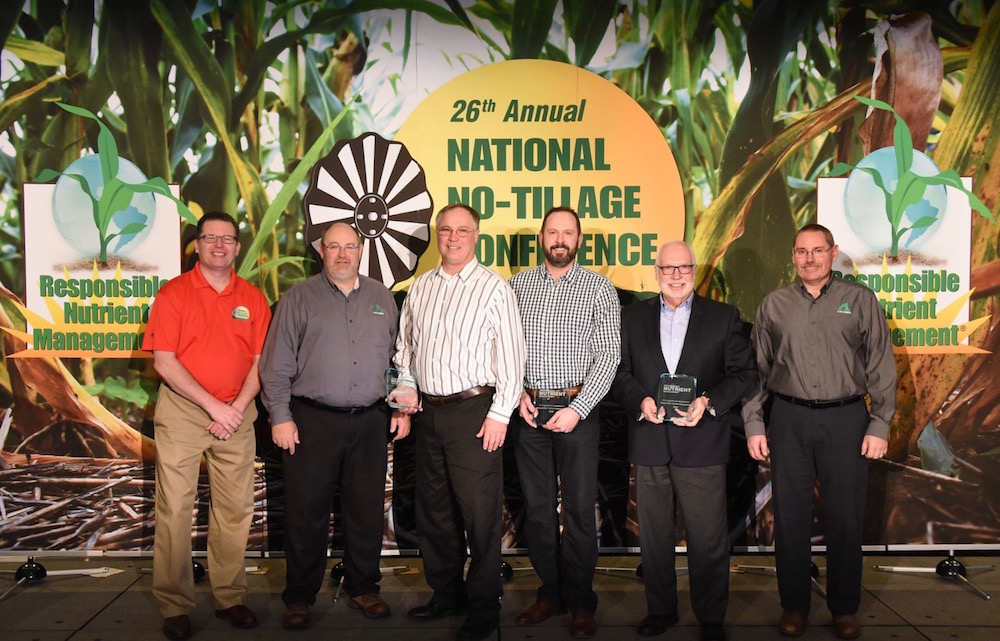LOUISVILLE, Ky. — Several growers have been honored for their efficient and effective use of applied fertilizer in their no-till systems. Considered Responsible Nutrient Management Practitioners, the no-tillers were honored before 900 farmers during the 26th annual National No-Tillage Conference.

The 10th class of Responsible Nutrient Management Practitioners includes (l-r, starting from 3rd to left) Jake Kaderly, Monticello, Wis.; Stuart Lawrence, Rosetown, Saskatchewan, Canada; and Richard Lyons, Harvel, Ill. Also pictured are (left) Darrell Bruggink, No-Till Farmer, (2nd from left) Rob Marquardt, AgroLiquid; and (right) Tim Duckert, AgroLiquid.
Richard Lyons, Harvel, Ill.; Jake Kaderly, Monticello, Wis.; and Stuart Lawrence of Rosetown, Saskatchewan, Canada, each shared five practices they utilize on their farms in an effort to use only necessary amounts of applied fertilizer and ensure it’s used by crops rather than lost to the environment.
Last year, all nominees for the 10th annual program answered more than 20 questions about their farming operations through an online application. Their responses were graded by a panel of fertility experts. The highest scorers were awarded the honor, along with complimentary travel to the conference and lodging from AgroLiquid and conference registration from No-Till Farmer. AgroLiquid and No-Till Farmer are co-sponsors of the Responsible Nutrient Management Practitioners Program.
Following are snapshots of fertility practices utilized by these no-tillers:
- Lyons strip-tills corn and no-tills soybeans and wheat on 300 acres in central Illinois. He aims to apply no more than 0.9 pounds of nitrogen (N) per every bushel of corn using split N applications in the fall, at-plant, sidedress and just prior to tasseling. He soil samples every 3 years on 2.5-acre grids and protects his N with inhibitors. Farming in a highly scrutinized watershed, Lyons uses fertility rates based on actual yields rather than projections, giving him flexibility to add N when necessary to achieve top-end yields. Cover crops are also building his soil organic matter.
- Kaderly raises 300 acres of corn, soybeans, wheat, alfalfa and cover crops in south-central Wisconsin. A certified crop consultant working with 15 other farms, Kaderly grid samples every 2 years and moves sample points to get a better understanding of field fertility levels. That allows him to correct for lime, phosphorus (P) and potassium (K) through variable-rate spreading. He is focused on improving soil nutrient balance, having spread gypsum to get closer to base saturation goals for calcium. He has reduced N rates to 0.7-0.85 pounds per bushel of corn.
- Lawrence no-tills 2,700 acres of barley, durum, spring wheat, canola, lentils, flax and canary seed on the Canadian Plains. He conducts a battery of soil tests annually, including a review of micronutrients. He places P and K in the seed furrow where roots can quickly access the nutrients. In-season tissue testing allows him to apply N and micronutrients like zinc as necessary to meet crop needs and achieve yield potential. Remote sensing technology allows Lawrence to create zone maps for variable-rate fertilizer applications.
“These three farmers have taken a serious approach to how they manage nutrients,” says Troy Bancroft, CEO of AgroLiquid. “They are continuously looking at ways to be more effective with their applied fertilizer so they can get the best return for their dollar, but also make sure that crops are utilizing these nutrients and that losses to the environment are vastly reduced or eliminated altogether. They are a great example for all farmers to follow.”
To get more details about these farmers’ fertility management programs and farming operations, click the button below. Also visit the Responsible Nutrient Management Practitioners page for further reading.
Read more on the fertility practices of the three winners >>







Post a comment
Report Abusive Comment